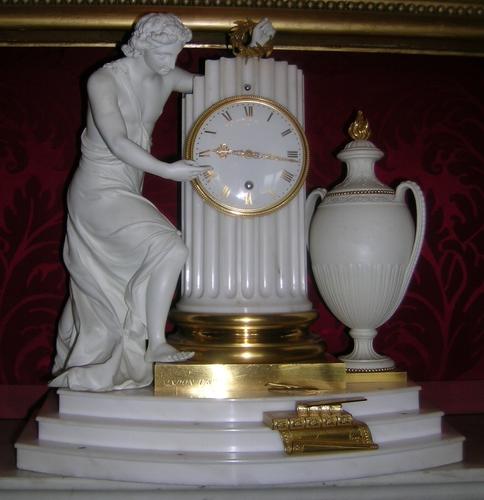Benjamin Vulliamy (1747-1811)
Mantel clock and pedestal 1787
Biscuit porcelain, gilt metal, enamel | 129.7 x 56.0 x 27.0 cm (whole object) | RCIN 30044
-
Timepiece within a circular fluted column on a square gilded base. The dial is of porcelain with the 12 hours represented by gilded Roman numerals and a pair of pierced gilt hands. A male figure of Apollo in classical dress to the left, holding a laurel wreath and pointing to the time; originally with a putto, now missing. To the right a classical two handled ovoid urn with a gilded flambeu. On the stepped marble base, two books and, written on a scroll, 'Fugit irreparible Tempus Virgil' - from Virgil 'irrecoverable time glides away'. The inspiration behind the development of this and other figural mantel clock cases was certainly that of Benjamin Vulliamy and it was he who arranged with William Duesbury to improve the production of Derby biscuit porcelain by employing a series of well-trained sculptor-modellers. The Apollo figure was modelled by the young sculptor John Deare, who left the Vulliamys’ employ in 1785 - it was available with or without wings, according to choice. The urn is also a Derby stock piece adapted for Vulliamy. The eight day timepieces has a fusee movement and ½ dead beat escapement. The enamel dial has the 12 hours represented in gilt Roman numerals and a pair of gilt pierced hands. Vulliamy number 1787 Harewood and satinwood tapering pedestal with a stepped base and inversely stepped cornice. At the centre an oval reserve decorated in grisaille with a representation of Apollo in his chariot, drawn by four horses and all framed by signs of the zodiac.
Provenance
Originally in small Blue Velvet Room, Carlton House and sent to Windsor in 1828.
-
Creator(s)
(clockmaker (movement))(porcelain manufacturer)(modeller)(nationality)Acquirer(s)
-
Medium and techniques
Biscuit porcelain, gilt metal, enamel
Measurements
129.7 x 56.0 x 27.0 cm (whole object)
Object type(s)








